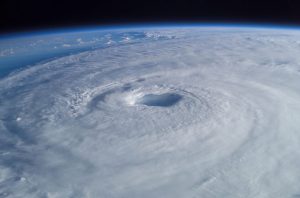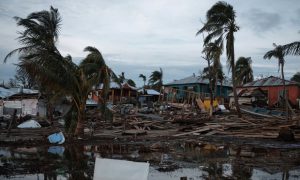 Hurricanes, typhoons, and cyclones are just different names for a powerful, rotating storm with thunder, lightning, and rain. Hurricanes are one of the atmospheres most powerful and dangerous forces. They are a major hazard to people, buildings, and the environment. Hurricanes kill more people each year than any other storm.
Hurricanes, typhoons, and cyclones are just different names for a powerful, rotating storm with thunder, lightning, and rain. Hurricanes are one of the atmospheres most powerful and dangerous forces. They are a major hazard to people, buildings, and the environment. Hurricanes kill more people each year than any other storm.
Hurricane is the term used for these storms in America, the Caribbean and Gulf of Mexico i.e. the Atlantic Ocean. In the Pacific Ocean, they are known as Typhoons, in the Indian Ocean as Cyclones and in Australia as willy-willies. Hurricanes and typhoons occur between the months of July and October in the Atlantic and the Pacific Ocean. In the Indian Ocean and off the Australian coast they occur from November to March.
A tropical storm is classified as a hurricane when wind speeds reach 74 miles per hour, though hurricane winds can be much faster. The center of a hurricane is called an ‘eye’, where winds are light and cloud is broken. Since 1954, all tropical storms have been given names so they can be identified quickly and told apart. The first storm of the year will be given a name beginning with ‘A’ for example Alexandra, the next with ‘B’ etc. Only women’s names were used in the past, but from 1979 alternate male and female names have been used. The names of powerful hurricanes, which caused a lot of damage, are never used again.
Hurricane Formation
 A hurricane may start as a small thunderstorm over a warm tropical ocean. If the water is warm enough (over 24ºC), a few storms may join together to create one larger storm. This storm’s eye may be just 200 miles across and have only gale force winds at first. Strong winds high in the atmosphere may make this storm start to rotate counter clockwise. As the storm moves west across the ocean it gains more energy by collecting more moist and warm air, spinning faster and in smaller circles. The storms eye may now be just 30 miles across and hurricane force winds swirl around it.
A hurricane may start as a small thunderstorm over a warm tropical ocean. If the water is warm enough (over 24ºC), a few storms may join together to create one larger storm. This storm’s eye may be just 200 miles across and have only gale force winds at first. Strong winds high in the atmosphere may make this storm start to rotate counter clockwise. As the storm moves west across the ocean it gains more energy by collecting more moist and warm air, spinning faster and in smaller circles. The storms eye may now be just 30 miles across and hurricane force winds swirl around it.
Hurricane Damage
Hurricanes, typhoons, and cyclones cause the most damage when they reach ‘landfall’. This means that they move from the ocean and cross over land. When this happens, land may suffer from other problems caused by the hurricane. These include flooding because of:
Storm surges and swells by the sea, which can create waves up to 6 meters high.
Hurricane waves up to 15 meters have also been created by the strong winds
Intensive heavy rainfall
Although a hurricane over land causes major damage it is also this landfall that causes the hurricane to weaken and eventually disappear.
Where and when a hurricane is going to develop can still not be predicted. However, once a large storm or hurricane has formed, its path can be tracked. Forecasts can then be made about if, when and where the hurricane may hit land. Satellites and radar are important in hurricane forecasting and strong, reinforced airplanes can be used to fly through and over hurricanes to conduct research.
North Atlantic Hurricanes
North America has the best hurricane warning system in the world. When winds of at least 74 miles per hour, storm surges and high sea levels are going to occur on coastlines, a hurricane warning is issued. These warnings are normally made on the television or through a flag system during the day and lanterns at night.
For seven years between 1995 and 2003, the hurricane activity in the North Atlantic Ocean has been above normal. The 2003 hurricane season (July to October), produced fourteen tropical storms from which developed seven hurricanes and three major hurricanes. These major hurricanes included:
Isabel – which became one of the most powerful hurricanes in history with a maximum sustained wind of 165 miles per hour. Hurricane Isabel also brought record flooding caused by storm surges to North East America, including Washington DC.Fabian – The most destructive hurricane to hit the tropical island of Bermuda for over 75 years.Did You Know
The most tree damage from a storm was in France on December 26th and 27th 1999. 270 million trees were felled or split, 87 people were killed and US$8 billion of damage was caused.
The most people left homeless by a tropical storm was when Hurricane Mitch hit Central America from October 26th to November 4th, 1998. The homes of 2.5million people were destroyed, totaling 93,690 dwellings.
The most expensive tropical storm in terms of damage costs was Hurricane Andrew which hit Florida, the USA from August 23rd-26th 1992. The bill for damage totaled US$15.5 billion.